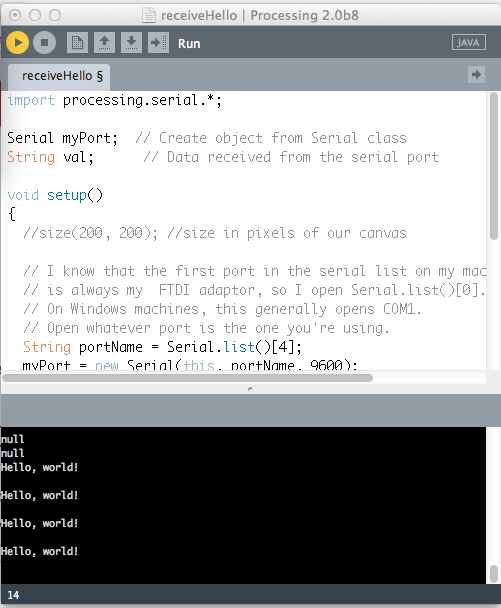

- #Arduino read integer from serial how to#
- #Arduino read integer from serial serial#
- #Arduino read integer from serial full#
- #Arduino read integer from serial code#
#Arduino read integer from serial code#
Too many times I have seen the following: if (Serial.available() > 0) ’ brackets missing and it’s not clear what code should be the default, or what should be the end of the function.
#Arduino read integer from serial serial#
Instead you should be reading the serial properly, taking account of line endings, and then converting the string you have read into a number using the likes of atoi(). Not only are they blocking, but often they just don't work right. If you know beforehand how many characters you are going to be receiving this can be a very handy and simple way of managing your receiving. Relying on the (poorly written) Arduino stream parsing routines is not good. The Arduino has a handy function: Serial.available(), which tells you how many characters are in the serial device’s receive buffer. Well, what a lot of new users don’t realise is that serial data arrives one character at a time, and you have little or no control over just when that data arrives.
#Arduino read integer from serial how to#
We will go through its introduction, working mechanism, pinout, and how to obtain readings from the sensor. I see many many questions on the Arduino forums from people trying to read data from a serial connection and not fully understanding how it works – and hence failing. In this user guide, we will learn about Force Sensor also known as FSR, and learn to interface FSR sensor Arduino using the Arduino IDE. It's more complex and expensive to have your if (counter != 0) than it is to simply unconditionally multiply-and-add.Due to WordPress’s abysmal handling of code blocks this blog post is now hosted at If you are using the ATmega328P, it has a dedicated MUL instruction that only takes two cycles. Graphical representation is available using serial plotter (Tools > Serial Plotter menu) Attach the center pin of a potentiometer to pin A0, and the outside pins to +5V and ground.
#Arduino read integer from serial full#
Ensure that one execution of loop maps to one full output integer / ReadAnalogVoltage Reads an analog input on pin 0, converts it to voltage, and prints the result to the serial monitor.


You loop while serial I/O is available: while (Serial.available())īut what if there is a pause in the availability of bytes in the middle of your integer? Your code will not do the right thing. Much of embedded electronics assumes ASCII encoding, and this is no exception, but you're still better off using the symbol instead of the code. You're better off writing if (received != '\n') While this is technically correct: if (received != 10) // Terminate if newline char detected Serial.println(number) // Print value inside number and reset Arduino Serial Read Number Arduino Serial Read Number excel, tutorial excel, step by step excel, how to use excel to be a smart Excel User in no Time. If (counter != 0) // Put number in its correct position (base-10 system) If (received != 10) // Terminate if newline char detected Returns the first readable byte in the serial port buffer, and returns -1 when there is no readable data, integer. Received = Serial.read() // Store received byte While (Serial.available()) // Read data in serial receive buffer Static uint32_t number = 0 // Store value from 0 to 4294967295 Serial.println(F("Serial port opened!"))

Serial.begin(9600) // Opens serial port, sets data rate to 9600 bps Please leave some feedback on ways to improve it. I believe i am writing the data correctly but am unsure since the data i get back from the arduino is the print out, b ' ', where i am only sending '1' and should be returning that a string that states 'serial available, X\. My current task is to just to communicate over serial from my python program to my arduino and back. Perhaps this is the right way to do it, although it doesn't detect and block letters and special characters. Hey everyone, I am starting a project with arduino and python. I couldn't find any code examples about this. I wanted to understand how integers can be written and stored inside variables without the use of Serial.parseInt().


 0 kommentar(er)
0 kommentar(er)
